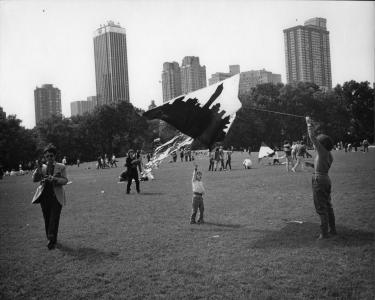Warhol’s Photographic Capitalist Caricatures
Andy Warhol once said ‘a picture means I know where I was every minute. That’s why I take pictures. It’s a visual diary’. Such a statement doesn’t sound too bizarre to an audience so familiar with the idea of seeing someone’s life chronicled on Facebook or Instagram.
All in black and white, Warhol’s photographs are certainly act like the visual diary Warhol describes. His subject matter include the descent into a subway station, his view from an airplane window, and an array of flavours available from an ice cream van, all of which are common to any man’s venture in 80’s America, or even today for the matter.
While the selection of photographs on display at The Photographer’s Gallery (tucked away in what probably is the most serene spot to be found on Oxford Street) does showcase a Warhol we may not be familiar with, the photography is still so Andy Warhol. One photograph captures a kitchen shelf, complete with Hellman’s mayonnaise and apple sauce, which isn’t so far removed from what he claimed to be his favourite work; the 32 Campbell’s Soup Cans. His focus on the mundane is still present, as is his obsession with celebrity and the darker side to capitalism. In what is perhaps the most striking photograph on display, Jerry Hall raises a glass to the camera; to us, the spectator, oozing with unapologetic glamour and decadence. Yet keeping in alignment with Warhol’s creation of mass-produced art, Hall’s image is presented in a montage. This montage is held together by string, silver in colour and left uncut for all to see. Warhol may have said, ‘I want to be a machine’, but in actual fact there is something greatly human about this body of work.
The photographs do not simply serve as documentation of a great artistic movement across America. Instead, Warhol’s images are politically charged in some cases, and thought provoking in all. One image gives us a wide shot of Manhattan’s Madison Avenue, but right next to it is another image – this time of a homeless man on the street. It almost feels as if Warhol is offering up a less gorgeous view of consumerist culture, which juxtaposes the fulfilled American dream with the most startling realistic contrast. The curator of the exhibition, Karen McQuaid, really must be applauded. The selection and placement of images do not stifle Warhol’s work in the slightest. The homeless man stands out amongst photographs of a dancing Liza Minnelli and a giggling Tina Turner. Images of stony looking mannequins in a shop window, a snapshot of a suit jacket, a fine cutlery set and a show bathroom, all encapsulate the idea that one’s life is validated by possessions and material wealth.
Yet Warhol’s knowledge of the hollowness of this materialistic way of life is what underlines the exhibition. The photograph of the suit is missing the man wearing it, and the mannequins are just that – fake, not alive. Even the most glamorous image on display, that of Jerry Hall is drenched in this unforgivable hollowness. The final image in her montage is so deliberately overexposed she becomes unidentifiable. This beckons the question, does it matter? The next generation will come along with another set of icons and celebrities to obsess over; it’s a ferocious circle. Warhol’s body of work simultaneously highlights both the beauty and the emptiness of consumerist culture, while he also captures the allure of it to the outsider. One snapshot captures the crowd of paparazzi waiting for Maria Shriver and Arnold Schwarzenegger; they are all observers and hanging on to catch that all-important glimpse. Warhol’s photographs of those living the good life and those not, shows just how much mainstream culture and counter-culture are dependent on one another. It was a varied understanding Warhol had of the world around him, and it’s an understanding still relevant today given we are living in that future he prophesised where ‘everyone will be famous for fifteen minutes’.

Comments